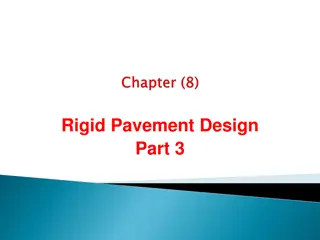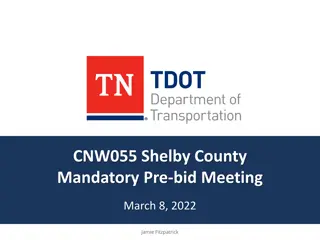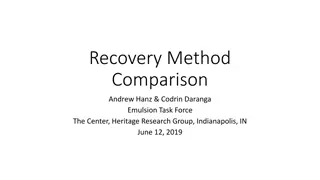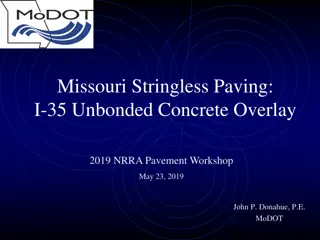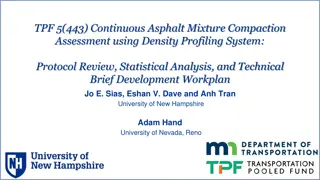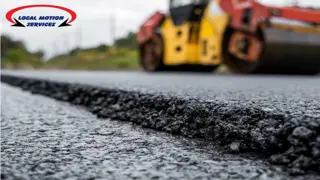Local Calibration and Verification for INDOT - PMED User Group Meeting
This presentation highlights the local calibration and verification process for the Indiana Department of Transportation (INDOT) from Version 2.3 to 2.6. The session covers the objectives, data collection, processing, and analysis conducted by Kumar Dave, Jusang Lee, and Matt Thomas. INDOT's key fac
1 views • 29 slides
Rigid Pavement Design: Stresses and Joint Types
Stresses due to temperature variation can affect concrete slabs, causing warping and friction stresses. Proper joint design, including expansion, contraction, and construction joints, is crucial to minimize stress and prevent warping in concrete pavements. This guide explores different types of join
4 views • 9 slides
National Highways completes £65 million upgrade of A11 - Transport Planning Asso
The Government-owned company responsible for the operation, maintenance, and improvement of England\u2019s motorways and major A roads has finished a \u00a365 million concrete reconstruction project on the A11 road at Wymondham. \n The scheme has entailed almost 10 miles of dual carriageway being up
8 views • 2 slides
RAP Incentive System: Revolutionizing Asphalt Recycling
RAP Incentive System, spearheaded by Robert C. Rea, P.E., promotes the use of Reclaimed Asphalt Pavement (RAP) in road construction by offering incentives to contractors. The system aims to address challenges like stockpile management, binder shortages, and escalating costs. Through a structured app
0 views • 22 slides
Request for Pavement Design
Seeking Pavement Design services in North Carolina for safe and efficient connectivity. Requests for designs go to Shihai Zhang, with specific criteria for projects to go through the Pavement Review Committee. Information needed includes project details, traffic data, and plans.
0 views • 4 slides
Quality Asphalt and Paving Solutions
Use Americanpavingtn.com superior asphalt and paving solutions to transform your parking lot or driveway. Count on our knowledgeable staff to provide excellent work.\n\n\n\/\/ \/\n
3 views • 2 slides
AASHTO Method for Highway Flexible Pavement Design
The AASHTO method for highway flexible pavement design is based on the AASHO Road Test results and has been revised over the years to provide guidelines for pavement structural design. It emphasizes performance period, time constraints, and design variables to ensure long-lasting and cost-effective
1 views • 25 slides
Safety Best Practices in Construction & Materials Conference - Harold Mullen Texas Asphalt Pavement Association
This content highlights safety best practices shared by Harold Mullen during the Texas Asphalt Pavement Association's 2021 Construction & Materials Conference. It emphasizes the importance of wearing PPE, being vigilant on the job site, obeying road safety rules, and spreading awareness to prevent r
0 views • 13 slides
Innovative Asphalt Product: BOND-X GREEN Regulations and Advantages
Explore the details of BOND-X GREEN, an innovative asphalt product that complies with regulations, offers high performance, and is user-friendly. Discover its composition, effects, competitive edge, and market adaptability, making it a cost-effective and environmentally friendly choice for asphalt a
0 views • 6 slides
Understanding Asphalt Binders in Pavement Construction
Asphalt binders play a crucial role in pavement construction, composed of three types of hydrocarbons: asphaltenes, resins, and oils. Different types of asphalt cements are produced for specific applications, such as liquid asphalts and asphalt emulsions. Quality control tests ensure the performance
0 views • 16 slides
SDDOT Asphalt Specifications and Benefits Overview
Detailed information on SDDOT asphalt specifications by Brad Remmich, covering FAA and state specifications, proposal, contract details, P-403 specs, testing guidelines, price adjustments, advantages of using SD specs, necessary bidding document inclusions, and key aspects to monitor during construc
0 views • 11 slides
Handling Bituminous & CPF Adjustments on Removal and Replacement of Asphalt
Learn how to manage bituminous and CPF adjustments when removing and replacing asphalt due to materials failure or workmanship issues. Understand the process for adjustments within the same lot or different lots, including entering tonnage, dates, and certifications. Follow step-by-step instructions
0 views • 8 slides
Shelby County Mandatory Pre-bid Meeting Presentation
This presentation showcases the proposed construction sequence for the mainline pavement section of the project in Shelby County. It includes detailed images and descriptions of various construction stages, such as the segments from W. McLemore Avenue to South of Crump Boulevard, the Crump/Roundabou
0 views • 65 slides
Pavement Preservation Treatment Knowledge Transfer Analysis
The analysis discusses the peer exchange facilitators, knowledge transfer process between Lead and Explorer States, disadvantages of limited knowledge transfer, and details of pavement preservation treatment experience in various states. It emphasizes the importance of sharing expertise to enhance p
0 views • 48 slides
Understanding Pavement Management Programs: A Comprehensive Overview
Discover the intricacies of a Pavement Management Program (PMP) through a detailed review presented to the Streets Sustainability Committee. Explore the historical practices, recent advancements, and key elements of the City's PMP. Learn about 450 centerline miles, street classifications, budget con
0 views • 28 slides
Influence of Seasonal Temperature on Pavement Reliability Performance: A Case Study
This case study explores the impact of seasonal temperature changes on pavement reliability performance (PRP) by analyzing crash and pavement data for three pavement types in a U.S. State, delving into how temperature affects asphalt properties and friction levels. The study compares crash trends fo
0 views • 26 slides
Pavement Engineering Overview: Types, Design, and Requirements
A comprehensive overview of highway pavement engineering, covering types of pavements, structural requirements, ideal pavement characteristics, and classifications into flexible, rigid, and composite pavements. Proper pavement design is crucial for ensuring long-lasting, safe, and high-quality road
0 views • 19 slides
Introduction to Rigid Pavement Design in Highway Engineering
Rigid pavements, made of cement or reinforced concrete slabs, are designed to resist traffic loads by distributing them over a wide area of soil. The design focuses on providing a structurally strong concrete slab. Minor variations in subgrade strength have little impact on rigid pavement capacity,
0 views • 13 slides
Selection of Layer Thickness in Highway Flexible Pavement Design
Selection of layer thickness for highway flexible pavement design involves determining an initial pavement structure's design structural number and then choosing appropriate thicknesses to meet or exceed the required structural number. Cost-effectiveness, construction constraints, and maintenance co
0 views • 11 slides
Insights from Asphalt Mixtures Testing Section Engineer's Meeting 2015
Discussed topics include FHWA audit on surface mixtures, regulatory compliance, acceptance procedures, NMAS changes in different mixes, durability issues, and use of recycled materials in asphalt mixtures. Suggestions made for running verification tests, extending sample retention time, and implemen
0 views • 10 slides
Microsurfacing Mix Analysis and Experiment Results
The content discusses various aspects of analyzing microsurfacing mixtures, including performing solvent extractions to determine asphalt content, comparing results from different mix compositions, and setting up experiments with limestone aggregate mix. It also covers expectations for asphalt conte
0 views • 10 slides
Recycled Asphalt Pavement and Recycled Concrete Aggregate: Survey Report
This survey report explores the production and properties of Recycled Asphalt Pavement (RAP) and Recycled Concrete Aggregate (RCA). It discusses the materials, nomenclature ambiguity, and physical properties of RAP and RCA, shedding light on their production methods, mechanical and physical characte
0 views • 42 slides
Enhancing Pavement Performance with Tiered Superpave Specifications
Explore innovative strategies in rethinking polymer-modified asphalt timing to reduce age-induced surface damage. Discover tiered cracking specifications, PG grade bumping for quality standards, and the evolving PG specifications for cracking resistance. Delve into research needs for optimizing pave
0 views • 10 slides
State Construction Engineer's Spec Changes in Paving Potpourri 2015
Assistant State Construction Engineer Bob Dyer and Secretary of Transportation Lynn Peterson discuss important spec changes in paving projects for 2015. Topics include elimination of anti-strip in HMA, density acceptance criteria, pavement smoothness, test frequency adjustments, and upcoming changes
0 views • 12 slides
Concrete Pavement Repair and Replacement Techniques
Explore different bid items and techniques used for concrete pavement repair and replacement, including base patching with Type B and Type C Family Concretes, consolidation methods, surface finishing options, and key similarities and differences between various materials. Gain insights into contract
0 views • 14 slides
Insights from the 55th Annual South Dakota Asphalt Conference
The 55th Annual South Dakota Asphalt Conference held in Pierre, SD in April 2016 brought together agencies, industry, and academia to discuss the future outlook of crude oil prices and the trajectory of asphalt pavement in South Dakota post-2000. Key topics included investment in crude oil, market b
0 views • 17 slides
Analysis of Recovery Methods for Emulsions in Asphalt Industry
This study compares the effectiveness of low temperature evaporation recovery methods in asphalt emulsions testing. The research evaluates different machines, film thicknesses, and recovery methods to understand their impact on the test results. Results show variability between labs and highlight th
0 views • 11 slides
Effective Pavement Management Program Overview
This program by the Pennsylvania Department of Transportation focuses on the importance of implementing preventive maintenance strategies at the right time for highway pavement management. It covers topics such as types of pavements, preventive maintenance concepts, treatment selection, and timing f
0 views • 14 slides
Climate Models and Moisture Equilibrium in Flexible Pavement Design
Climate inputs like temperature and moisture play key roles in flexible pavement design. The heat transfer model evaluates frost action and temperature regimes, while moisture equilibrium models consider the interaction between soil suction and moisture content. Understanding these factors is crucia
0 views • 13 slides
Missouri Stringless Paving Project on I-35 in Clay County
The Missouri Stringless Paving Project on I-35 in Clay County involved the installation of an Unbonded Concrete Overlay on approximately 8.3 miles of pavement in both northbound and southbound directions. The project included milling off the existing pavement, installing a geotextile interlayer, and
0 views • 33 slides
Understanding Asphalt Binder Fatigue Characterization
This comprehensive study delves into the fatigue characterization of asphalt binders using Linear Amplitude Sweep (LAS) testing. It covers various aspects such as theoretical foundations, testing methods, equipment used, and analysis of results. Additionally, it explores Superpave specifications, bi
0 views • 35 slides
Continuous Asphalt Mixture Compaction Assessment Using Density Profiling System
Development of a comprehensive work plan for the assessment of asphalt mixture compaction using the Density Profiling System (DPS). The project aims to create a master database of field and lab measurements, refine protocols for dielectric value-density relationships, propose changes for sensor bias
0 views • 11 slides
Nonlinear Analysis of Pavement Structural Stresses and Deflections
Explore the effect of nonlinearity in granular materials on vertical stresses and deflections in pavement structural analysis. Learn about iterative methods and stress invariants to understand pavement behavior under traffic loads. Discover the application of Boussinesq's solutions and Burmister's l
0 views • 20 slides
Enhancing Scrub Seal Emulsions for Asphalt Mix Rejuvenation
Activities of the Spray Group involve developing effective materials specifications for scrub seal emulsions with rejuvenators to properly rejuvenate cracked asphalt mixes. The purpose is to ensure successful applications with the most effective products. Consideration of elastic polymers, non-elast
0 views • 4 slides
Pavement for Cities: A Detailed Business Plan by DLS-Construction GmbH
This detailed business plan by Sascha Kindermann, Lothar Kunz, and Diana Hennings explores various aspects of pavement for cities, including calculations, advantages, disadvantages, financing, applications, and road construction. It covers the definition of pavement, its types, advantages like durab
0 views • 27 slides
Denver asphalt repair
Local Motion Services excels in Denver asphalt repair, offering crack sealing, patching, and seal coating to enhance curb appeal and value.
1 views • 4 slides
Denver Asphalt Repair
Local Motion Services offers expert Denver asphalt repair, that specialize in commercial and residential initiatives. Whether it is solving potholes, cracks, or resurfacing driveways, their crew guarantees long lasting, superb effects.
2 views • 4 slides
Analysis of Asphalt Mix Test Results at Michigan Technological University
Conducting various tests on asphalt mixes at Michigan Technological University revealed differences in properties such as TSR values, compaction processes, and air void percentages. Mixes SPWED430I and SPWED440E exhibited challenges in achieving required air void percentages, while anti-stripping ag
0 views • 6 slides
Understanding Typical Layers of Flexible Pavement in Highway Engineering
The typical layers of a conventional flexible pavement include seal coat, surface course, tack coat, binder course, prime coat, base course, sub-base course, compacted sub-grade, and natural sub-grade. Each layer serves a specific purpose in providing strength, durability, and drainage characteristi
0 views • 9 slides
Cost Analysis of Concrete vs. Asphalt
Explore the cost differences between concrete and asphalt to find the best option for your project. Get insights on durability & maintenance.\n
1 views • 7 slides

